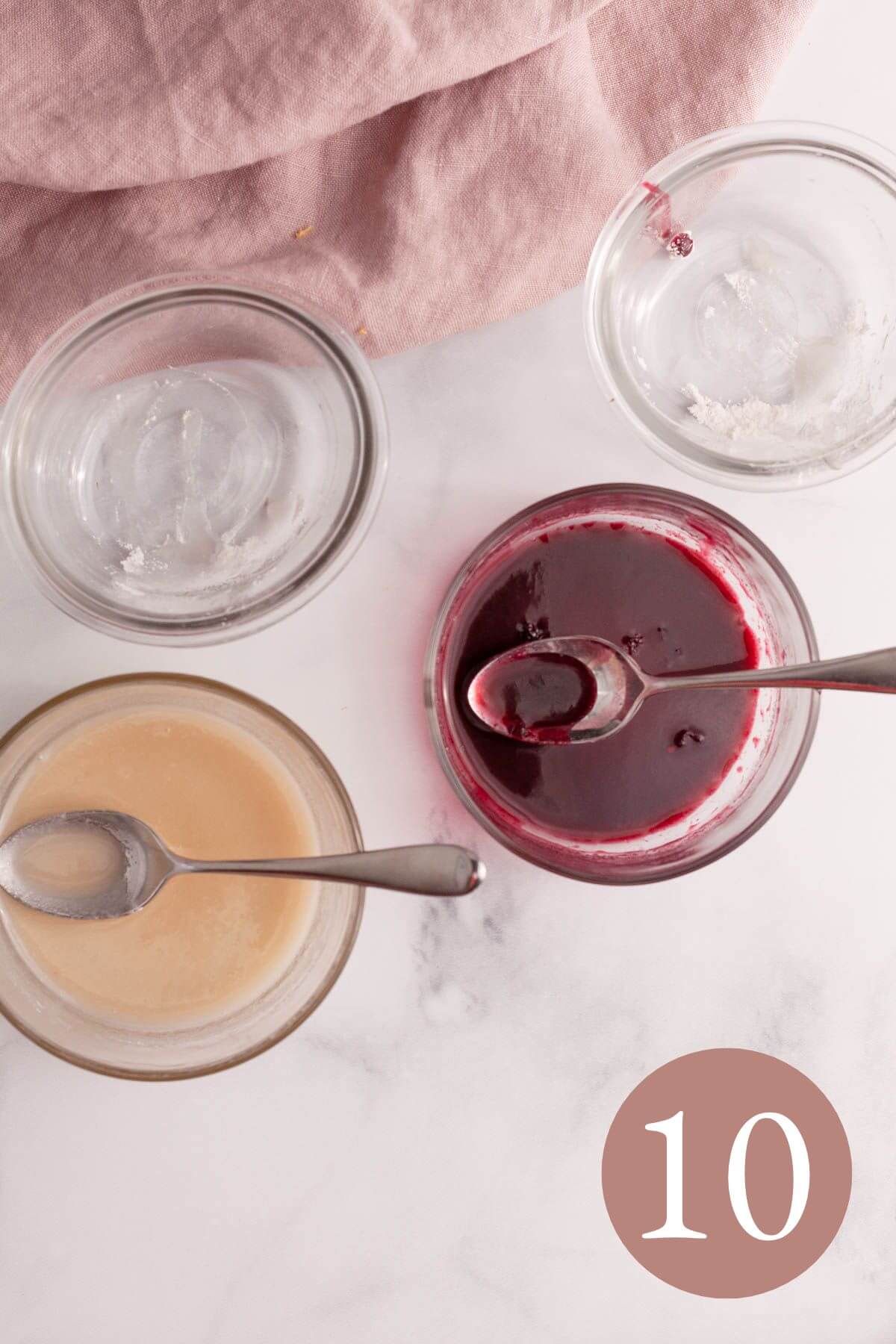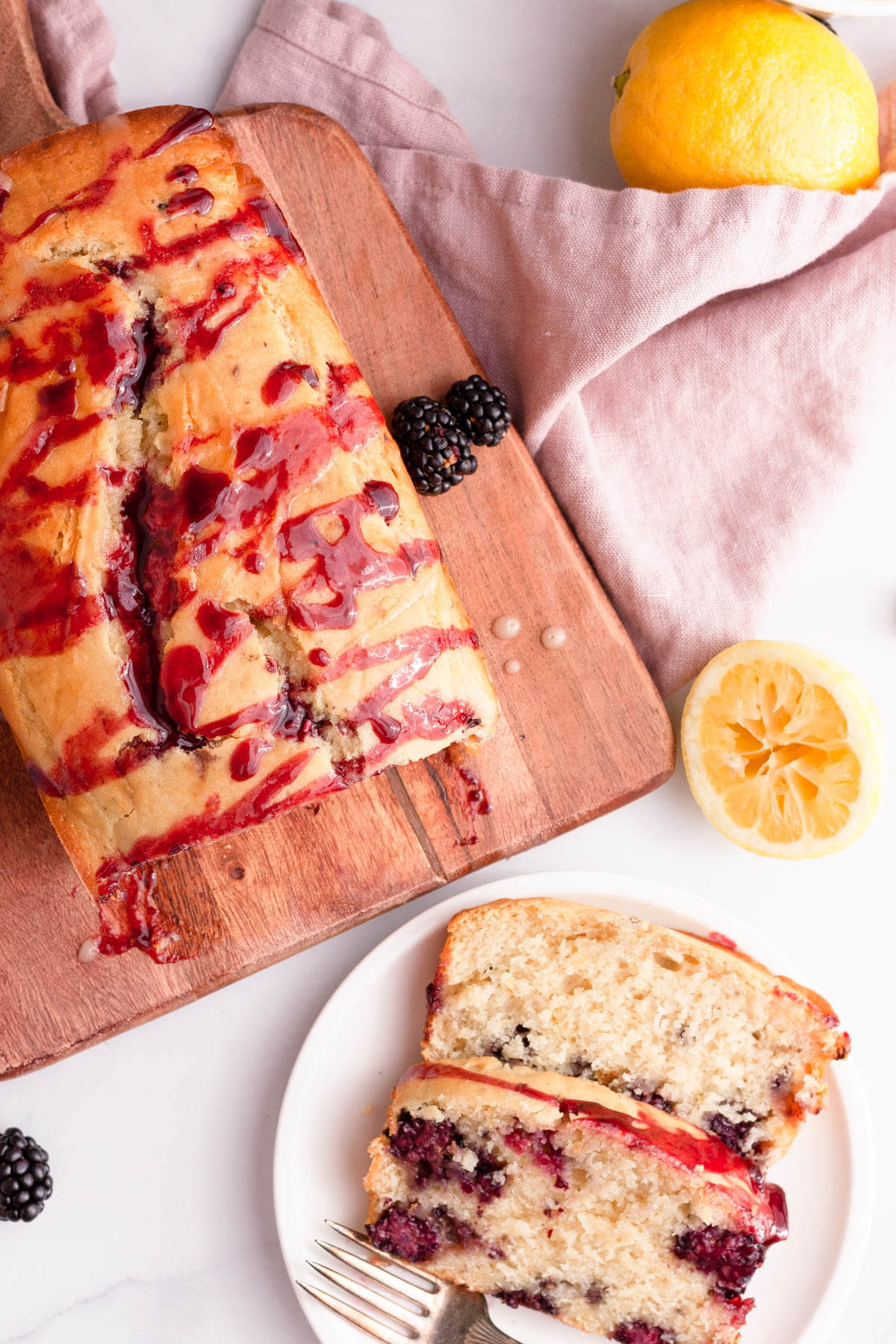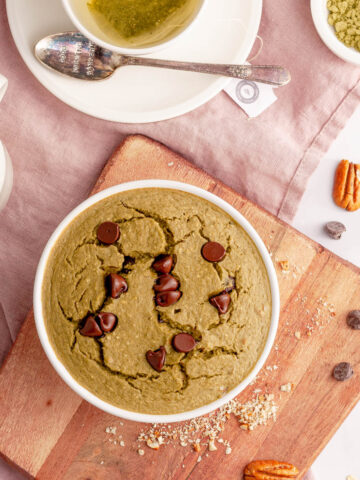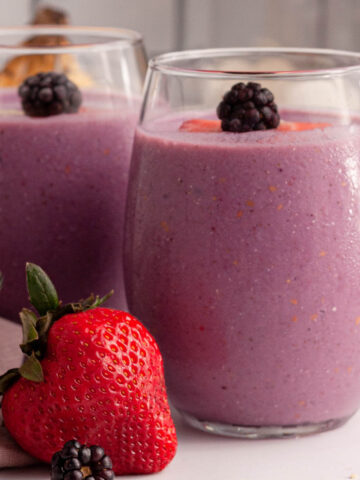A celebration of bright citrus flavor and ripe berries, blackberry lemon bread is our new summertime favorite quick bread. Bursting with delicious flavors, yet lovingly made with vegan ingredients, you can bake a loaf that harnesses more sustainable choices. This recipe includes fresh lemon juice and zest, fresh blackberries, and both lemon and blackberry glaze. Now, that’s delicious!

Jump to:
Lemon and blueberry might be a classic partnership, but the lemon-blackberry friendship deserves some time to shine. In the American South, blackberry bushes appear on properties with apparent ease…even vining their way through fence openings to offer a little fruit for people or birds (whoever reaches them first). If you have the opportunity to nurture a blackberry bush, you can grow your own and make this dish even more fresh!
If you’re a fan of one of our most popular recipes – vegan lemon poppy seed pancakes – then you will find this to be a tasty companion to keep in rotation!
❤️ What you’ll love about this blackberry lemon bread
Texture. A cross between a traditionally-hearty quick bread and the fluffiness of cake, this blackberry lemon bread is fluffy enough to feel like you’re eating cake, but sturdy enough to hold the heavier blackberry pieces.
Flavor. There’s no shortage of lemon flavor here! With both fresh lemon juice and robust lemon zest, citrus notes play a strong role in this loaf. Plant-based buttermilk (plant-based milk and lemon juice) creates a little tanginess to balance the sweetness, while also replacing the need for yogurt or sour cream.
Vegan. When we harness plant-based ingredients, we accomplish multiple goals at once: (1) the loaf is made with more sustainable ingredients that help the earth, and (2) we make a baked good friendly to a wider audience that faces dietary restrictions. If you also follow a gluten-free diet, you are welcome to substitute the unbleached all-purpose flour with gluten-free flour.
🥣 Ingredient List

Dry Ingredients
Unbleached all-purpose flour. I prefer unbleached flour, but this recipe will work with the all-purpose flour of your choosing. I do not recommend self-rising flour “as is,” unless you make necessary adjustments to remove leavening agents.
Baking powder. The baking powder does the heavy lifting to create rise in this bread dough.
Baking soda. Adding baking soda creates even more rise, since it activates when it comes into contact with acidic ingredients, including the plant-based buttermilk and lemon juice.
Kosher salt. Select a salt that has a finer grain than sea salt, to allow for it to evenly incorporate throughout the mixture. I used Pink Himalayan for this recipe.
Cream of tartar. The cream of tartar helps the aquafaba whip into stiff peaks.
Wet Ingredients
Unsweetened plant-based milk. Choose the plant-based milk that suits your preferences. I used soy in this recipe. The milk will be “curdled” with the addition of lemon juice, to create a plant-based buttermilk.
Organic cane sugar. You can use granulated sugar, but keep in mind that many brands (in the U.S., for example) refine their sugar with bone char (making them non-vegan).
Refined coconut oil. Use a neutral-flavored oil of your choosing. Refined coconut oil does not add a coconut flavor to the bread.
Pure vanilla extract. Everything is made better with vanilla! Add for depth of flavor and a hint of sweetness.
Vegan powdered sugar. Use this for the glazes.
Lemon juice. Fresh lemon juice is added both to the plant-based milk (to create plant-based buttermilk) and the batter itself.
Aquafaba. This is the reserved liquid from chickpeas or garbanzo beans, most commonly drained from canned varieties. Aquafaba can be whipped into stiff peaks which creates a lighter, more fluffy structure in the texture of the bread and replacing the need for traditional eggs.
Add-ins
Fresh blackberries. I reserve a few blackberries to press for juice to use in the blackberry glaze. Additionally, I cut half the blackberries into halves, so they can spread out a little more in the bread itself. This step is optional, and you are welcome to use frozen berries.
Lemon zest. The zest from the lemons adds a stronger lemon flavor and creates beautiful little flecks of yellow throughout the blackberry lemon bread. Reserve a little to sprinkle over the top of the finished product, if desired.
🔪 Equipment

- Loaf pan
- Measuring spoons
- Measuring cup
- Mixing spoons
- Stand or hand mixer
- Bowls
- Whisk
- Knife (optional, for cutting berries)
- Small saucepan
- Cutting board (optional, for cutting berries)
👩🏽🍳 Instructions
Preparation Steps




Preheat oven to 350ºF and make sure a rack is placed in the center of the oven.
Add the juice of one lemon to the plant-based milk, stir with a spoon, and allow to rest on the counter while you prepare the remaining ingredients.
In a small saucepan, add the aquafaba. Place a small glass bowl over the top of the saucepan (creating a double broiler) and add coconut oil. Over low heat, melt the coconut oil before removing from the saucepan and setting aside. Allow the aquafaba to reduce for a few minutes, until the liquid is more viscous and cloudy.
Add the aquafaba to the bowl of stand mixer (with whisk attachment) or bowl for a hand mixer. Include cream of tartar. Whisk on high speed until the aquafaba forms stiff peaks. This should just take a few minutes, but can take longer depending upon the strength of your machine and the viscosity of the aquafaba.
Take about ½ cup of the fresh blackberries and cut in half, if desired.
Quick Bread Batter Steps




In a small bowl, whisk the dry ingredients, including the all-purpose flour, baking powder, baking soda, and kosher salt.
In a larger bowl, add the wet ingredients: plant-based buttermilk, organic cane sugar, coconut oil, vanilla extract, lemon juice from two lemons, and lemon zest. Reserve some lemon zest for garnish, if desired.
Add the dry ingredients to the wet, incorporating in small batches until all the dry ingredients are added. A few small lumps are “ok,” but should be barely noticeable.
Gently fold in the whipped aquafaba until fully combined with the dough.
Gently stir in the blackberries, reserving about ¼ cup of blackberries for the glaze.
Pour the dough into a greased or parchment-lined loaf pan. Bake for 45-55 minutes, or until a toothpick inserted in the center of the loaf is clean when removed. The loaf will be lightly browned on top and around the edges. Remove from the oven and allow to cool for about 10 minutes before inverting onto a wire cooling rack.
Glazes


Blackberry Glaze Steps
To make the fresh blackberry glaze, add the blackberries to a saucepan and heat over low temperature. Gently press the blackberries with the back of a spoon, to release the juice.
Over a fine mesh strainer, separate the blackberry pulp from the juice.
Add the powdered sugar to the juice (slowly) and stir to combine, until you reach the desired consistency. Add more powdered sugar to thicken, or thin with more blackberry juice, or a few drops of water.
Lemon Glaze Steps
Add powdered sugar to one teaspoon of fresh lemon juice, stirring to combine. Add more powdered sugar to thicken, or a few drops of water (or more lemon juice) to thin.
Drizzle the glazes over the top of the cooled blackberry lemon bread. Create a criss-cross pattern over the top of the bread, if desired. Sprinkle with a little more lemon zest (optional).

Pro Tip: Take a portion of your blackberries (about half, in this recipe) and cut them in half to create smaller berries before stirring into the batter. This helps distribute the berries more evenly throughout the batter. There is no need to coat the blackberries in flour to suspend them in the batter.
Recipe

Blackberry Lemon Bread
Equipment
- 1 stand or hand mixer
- 1 set of measuring cups
- 1 set of measuring spoons
- 1 set of mixing bowls include one small glass bowl to use as a double broiler
- 1 small saucepan
- 1 loaf pan I used a 9-inch by 5-inch ceramic loaf pan
- 1 whisk
- 1 knife optional, for cutting blackberries
- 1 cutting board optional, for cutting blackberries
- 1 wire cooling rack
Ingredients
Dry Ingredients
- 2 cups unbleached all-purpose flour or 1:1 gluten-free flour
- 2 teaspoons baking powder
- 1 teaspoon baking soda
- ½ teaspoon kosher salt I used pink Himalayan salt
- ⅛ teaspoon cream of tartar
Wet Ingredients
- 1 cup plant-based milk I used soy
- ⅔ cup organic cane sugar or 1:1 sweetener of your choosing
- ¼ cup coconut oil
- 7 tablespoons aquafaba juice from canned or cooked chickpeas
- 3 tablespoons + 1 teaspoon fresh lemon juice
- 2 tablespoons vegan powdered sugar for glaze
- 1 teaspoon pure vanilla extract
Add-ins
- 3 ½ tablespoons lemon zest approximately 3 ½ lemons
- 1 ¼ cup fresh blackberries frozen is acceptable
Instructions
Preparation
- Preheat oven to 350º Fahrenheit.
- In a measuring cup, add plant-based milk. Stir in one tablespoon of fresh lemon juice and allow to sit while preparing other ingredients.1 cup plant-based milk, 3 tablespoons + 1 teaspoon fresh lemon juice
- If desired, cut ½ cup of the blackberries in half and set aside.1 ¼ cup fresh blackberries
- Add aquafaba to a small saucepan and place over low-medium heat on the stove. Place a small glass bowl over the saucepan to create a double broiler.7 tablespoons aquafaba
- Add the coconut oil and melt until translucent (only takes a few minutes). Set aside.¼ cup coconut oil
- Cook the aquafaba for a few more minutes, allowing it to reduce slightly and create a more "cloudy" appearance.7 tablespoons aquafaba
- Add the cooked aquafaba to the bowl of a stand or hand mixer (whisk attachment for stand mixer) along with the cream of tartar.7 tablespoons aquafaba, ⅛ teaspoon cream of tartar
- Whisk on high speed for 3-5 minutes, or until the aquafaba forms stiff peaks.7 tablespoons aquafaba, ⅛ teaspoon cream of tartar
- Grease your loaf pan, or add parchment paper and clamp on each side for easy removal.
Quick Bread Batter
- Whisk the all-purpose flour, baking powder, baking soda, and salt together in a small or medium bowl.2 cups unbleached all-purpose flour, 2 teaspoons baking powder, 1 teaspoon baking soda, ½ teaspoon kosher salt
- Whisk the plant-based buttermilk, organic cane sugar, vanilla extract, remaining lemon juice, and coconut oil together in a large bowl.1 cup plant-based milk, ⅔ cup organic cane sugar, ¼ cup coconut oil, 3 tablespoons + 1 teaspoon fresh lemon juice, 1 teaspoon pure vanilla extract
- Slowly add the dry ingredients to the wet in batches, stirring to incorporate each time. A few small lumps are acceptable, but the batter should be mostly consistent.
- Stir in the lemon zest.3 ½ tablespoons lemon zest
- Fold in the whipped aquafaba until incorporated.7 tablespoons aquafaba
- Gently fold in 1 cup of the blackberries (including the halved berries) until incorporated throughout the batter.1 ¼ cup fresh blackberries
- Spoon the batter into the loaf pan. Bake for 45-55 minutes on the center rack in the oven. Test with a toothpick or skewer. The bread should be lightly browned on the top and edges, and the toothpick should be clean upon removal.
- Allow to cool for up to 10 minutes in the loaf pan before transferring to a wire rack.
Blackberry Glaze
- In a small saucepan over low heat, gently heat the remaining ¼ cups of fresh blackberries.1 ¼ cup fresh blackberries
- Using the back of a spoon, gently press the blackberries until they release their juice.1 ¼ cup fresh blackberries
- Pour the blackberry pulp through a fine mesh strainer to separate the juice.1 ¼ cup fresh blackberries
- Stir in one tablespoon vegan powdered sugar into the blackberry juice until you reach the desired consistency. Thicken with more powdered sugar, or thin with a little water.2 tablespoons vegan powdered sugar
Lemon Glaze
- Add about one teaspoon of fresh lemon juice to the second tablespoon of vegan powdered sugar and stir to combine. Thicken by adding more powdered sugar, or thin with a little water.3 tablespoons + 1 teaspoon fresh lemon juice, 2 tablespoons vegan powdered sugar
- Drizzle both glazes over the cooled bread, making a pattern of your choosing. Sprinkle with a little lemon zest, if desired.
Notes
Nutrition
🧊 Storage Instructions
There is no need to refrigerate the blackberry lemon bread, which will create a more dense result when removed from the refrigerator. Instead, store in an airtight container in a cool, dark place (like your pantry). Use within 7 days. Otherwise, you can freeze the bread for up to three months. Wrap the bread in plastic wrap, then in aluminum foil, and freeze.
✅ Acceptable Substitutions
1:1 Sweetener Replacement. If you need to watch your sugar intake, consider substituting the organic cane sugar with a sweetener, such as Truvia or Stevia. Be sure to use a 1:1 sugar replacement.
Gluten-Free Flour. Replace all-purpose flour with a 1:1 gluten-free flour substitution.
Blueberries. If you aren’t a fan of blackberries, or prefer a sweeter berry, substitute the blueberries for the blackberries. There is no need to cut the blueberries in half due to their small size.
Raspberries. Replacing blackberries with raspberries will keep the sweet-tart flavor, with a little more sweetness.
Cranberries. Consider incorporating frozen cranberries into the batter, to replace blackberries. This works especially well if you decide to replace the lemon juice and zest with orange juice and zest.
Orange. Not a fan of lemons? Use the zest of fresh oranges, as well as their juice, for a loaf that will be especially popular during the winter months.
Vegan yogurt or sour cream. Choose a neutral-flavored variety to replace the plant-based buttermilk. This will add more calories to the loaf.
Chocolate Drizzle. Instead of glaze, melt vegan chocolate and drizzle over the top of the loaf.

🍫 Creative Variations
Chocolate. Add vegan chocolate chips as a “mix in” or as a substitution to the berries.
Nuts. Dry roast plain nuts in a skillet for a few minutes before adding to batter.
Matcha powder. Incorporate a little matcha powder into the batter. This tastes particularly great with nuts and/or berries.
Make mini muffins or large muffins. Divide the quick bread batter among a muffin tin or mini muffin tin.
🍞 Tips for the Perfect Loaf
- Grease the pan or add parchment paper for easy removal.
- Allow most of the cooling to take place on a wire cooling rack, to prevent condensation from making the bottom of the loaf too moist.
- Resist the urge to overmix. For each step, mix until just combined.
Interested in learning more about making quick breads in advance, and freezing for later use? Review this quick bread article that guides you through additional tips to make the perfect loaf.
♻️ Sustainability Profile

The most sustainable factor in this recipe is the fact it is vegan. Just by sticking with non-dairy ingredients, you are baking a dish that reduces our carbon footprint and emission-producing practices.
Seasonality plays an important role in any recipe that calls for berries. If you are able to grow your own, organic blackberries – wonderful! That is the ideal scenario. Otherwise, aim to buy locally, organic, and/or non-GMO varieties. If you do grow berries in your yard, you will probably fight wildlife to harvest them when ripe. Whenever possible, don’t harvest the full amount of your berries – leaving some for birds and other wildlife is beneficial to the ecosystem. Sharing is caring!
Plant-based milk is more prevalent than ever. Soy milk is relatively sustainable compared to other options (almond milk, for example), and much more eco-friendly than cow’s milk. Select the option that works best for you.
Both the fresh lemons and the aquafaba are examples of ingredients that pull “double duty” in the cooking process. For example, when making delicious roasted chickpeas (like these chili lime roasted chickpeas), reserve the liquid in the can to make a vegan-friendly egg replacement. Reuse your spent lemon halves as refreshing food to grind in the garbage disposal when it needs a little odor elimination.
The majority of the items in this recipe includes common pantry ingredients that are easily incorporated into other recipes, reducing the need for specialty items.
❓Frequently Asked Questions
What is lemon bread made of?
Components for the ideal lemon bread consist of lemon-forward flavor, usually achieved by combining lemon juice with lemon zest. If fresh lemons are available, their flavor is usually more balanced and bright, making it particularly delicious. Of course, a sweetener (typically sugar) and a source of tanginess (plant-based buttermilk in this recipe) balance the sharper citrus notes for a bread that is both complex and delicious.
How do I keep my bread from sinking in the middle?
Prevent blackberry lemon bread from sinking in the middle by following a few simple steps. (1) First, don’t overmix the batter. The mixing should be done by hand (not in a stand or hand mixer), and each step should be stirred just until combined. (2) Bake the bread in the center of the oven and check for doneness by inserting a toothpick into the middle of the loaf before deciding if the bread is done. The toothpick or skewer should be clean when removed from the loaf. (3) If your bread sinks after following these steps, check the date on your leavening agents (baking powder and baking soda) and (4) make sure you whipped the aquafaba to the stiff peak stage.
What’s zesting a lemon?
Zesting a lemon requires using a zester, grater, or knife to remove the top, outer layer of lemon skin. This ingredient adds a powerful flavor to recipes that is both sharp, yet refreshing. In other words...zesty.
What are three uses of lemons?
Our favorite uses for lemons are (1) a source of flavor in both sweet and savory juices, whether through their zest or their juice, (2) a cleansing agent when needed to help remove a stubborn stain on cutting boards, or (3) a refreshing food item to process in the garbage disposal (when seeds are removed) after juicing the lemon.
😍 You might also enjoy...











Cliff says
One of my favorite breads, great as a sweet breakfast treat or as a decadent dessert. Easy to make and holds together well. 10 out of 10, would recommend!
Melanie Lorick says
Thank you so much! Thrilled you like it!
Tavo says
What a delicious treat! We made the blackberry bread yesterday for brunch, and it was fantastic!
Melanie Lorick says
That's wonderful, Tavo! I'm glad to hear it, and very much appreciate your review!
Andrea says
this blackberry lemon bread is the best! so good!
Melanie Lorick says
Woohoo! Thank you so much, Andrea!
Natalie says
Made your beautiful blackberry bread with my kids. We added some chocolate and made the best quick dessert ever, thanks!
Melanie Lorick says
I'm so glad to hear you enjoyed it with chocolate - that is a flavor powerhouse! Thank you for your review...I really appreciate it!
nancy says
made this delish blackberrry bread and the kids are obsessed with it. It was super moist and soft and everyone had seconds
Melanie Lorick says
Now, I consider that a success! 😂 Thanks so much for taking the time to let me know - I hope it's a recipe that will bring big smiles for years to come!
Maiko says
This bread was super delicious!! So fluffy and moist, everyone loved it at the home party I brought it to. Definitely making it again!
Melanie Lorick says
That is wonderful, Maiko! Thank you so much for sharing!! 😊
Katie says
I Love this blackberry lemon loaf! Super flavorful, and delicious! I love the tart mix of blackberries and lemon.
Melanie Lorick says
I'm so glad to hear it, Katie! Blackberries and lemon are the new classic flavor combination. 😉 Thanks for your review!